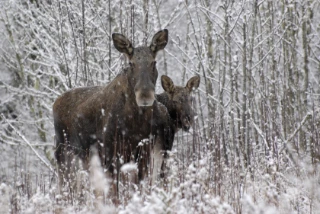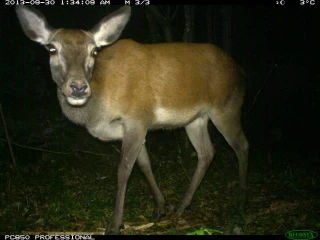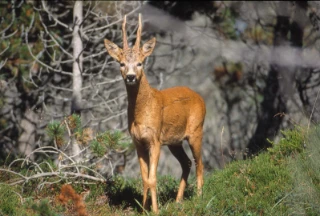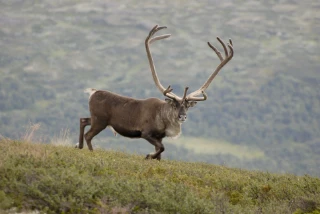Hjortedyrfamilien
Cervidae
Hjortedyr hører til klovdyrene, en gruppe planteetere med to klover på hver fot, og de er drøvtyggere. Hjortedyr har øynene plassert på siden av hodet. Dermed kan de oppfatte bevegelser uten å snu seg, og raskt flykte fra eventuelle rovdyr.
- Innhold
- Siden siteres som:
Geviret er kanskje det som kjennetegner hjortedyrene best. Med unntak av villrein er det bare hannen som har gevir. Geviret felles årlig, og blir større for hver gang det vokser ut.
I Norge har vi fire arter i hjortedyrfamilien; elg, hjort, rådyr og villrein. I tillegg finnes det et lite antall viltlevende dåhjort i Østfold. Dåhjort er imidlertid en introdusert art i Norge.
Størrelsen varierer i stor grad. Fra vårt minste hjortedyr - rådyret, til skogens konge - elgen.
Kilder
Andersen R, Duncan P og Linnell JDC (red.) (1998). The European Roe Deer: The biology of success. Scandinavian University Press. 376 s.
Andersen R og Hustad H (red.) (2004). Villrein & Samfunn. En veiledning til bevaring of brukav Europas siste villreinfjell. NINA Temahefte 27. 77 s.
Arntsen GB (2011). Gaupas (Lynx lynx) predasjon på tamrein (Rangifer tarandus) i Nord-Norge. Er gaupa selektiv? (Masteroppgave). Universitetet for Miljø- og biovitenskap. 36 s.
Austrheim G, Solberg EJ og Mysterud A (2011). Spatio-temporal variation in large herbivore pressure in Norway during 1949-1999: has decreased grazing by livestock been countered by increased browsing by cervids?. Wildlife Biology 17: 286-298.
Bevanger K, Linnell JDC, Odden J og Strand O (2013). Rovvilt og villrein. En kunnskapsstatus med utgangspunkt i Blefjellområdet. NINA Rapport 978. 57 s.
Bergerud AT (1988). Caribou, wolves and man. Trends in Ecology and Evolution 3: 68-72.
Bevanger K og Jordhøy P (2004). Villrein – fjellets nomade. Naturforlaget, Oslo. 168 s.
Bjørneraas K, Herfindal I, Solberg EJ, Sæther BE, Van Moorter B og Rolandsen CM (2012). Habitat quality influences population distribution, individual space use and functional responses in habitat selection by a large herbivore. Oecologia 168: 231-168.
Bjørneraas K, Solberg EJ, Herfindal I, Van Moorter B, Rolandsen CM, Tremblay J-P, Skarpe C, Sæther B-E, Eriksen R og Astrup R (2011). Moose Alces alces habitat use at multiple temporal scales in a human-altered landscape. Wildlife Biology 17(1): 44-54.
Cagnacci F, Focardi S, Heurich M, Stache A, Hewison AJM, Morellet N, Kjellander P, Linnell JDC, Mysterud A, Neteler M, Delucchi L, Ossi F og Urbano F (2011). Partial migration in roe deer: migratory and resident tactics are end points of a behavioural gradient determined by ecological factors. Oikos 120: 1790-1802.
Debeffe L, Focardi S, Bonenfant C, Hewison MAJ, Morellet N, Vanpe C, Heurich M, Kjellander P, Linnell JDC, Mysterud A, Pellerin M, Sustr P, Urbano F og Cagnacci F (2014). A one night stand? Reproductive excursions of female roe deer as a breeding dispersal tactic. Oecologia 176: 431-443.
Eriksen A, Wabakken P, Zimmermann B, Andreassen HP, Arnemo, JM, Gundersen H, Liberg O, Linnell JDC, Milner JM, Pedersen HC, Sand H, Solberg EJ og Storaas T (2011). Activity patterns of predator and prey: a simultaneous study of GPS-collared wolves and moose. Animal Behaviour 81: 423-431.
Eriksen A, Wabakken P, Zimmermann B, Andreassen HP, Arnemo JM, Gundersen H, Milner JM, Liberg O, Linnell JDC, Pedersen HC, Sand H, Solberg EJ og Storaas T (2009). Encounter frequencies between GPS-collared wolves (Canis lupus) and moose (Alces alces) in a Scandinavian wolf territory. Ecological Research 24(3): 547-557.
Flydal K, Hermansen A, Enger PS og Reimers E (2001). Hearing in reindeer (Rangifer tarandus). Journal of Comparative Physiology A 187: 265-269.
Fryxell JM, Greever J og Sinclair ARE (1988). Why are migratory ungulates so abundant? American Naturalist 131: 781-198.
Gervasi V, Nilsen EB, Sand H, Panzacchi M, Rauset GR, Pedersen HP, Kindberg J, Wabakken P, Zimmermann B, Odden J, Liberg O, Swenson JE og Linnell JDC (2011). Predicting the potential demographic impact of predators on their prey: a comparative analysis of two carnivore–ungulate systems in Scandinavia. Journal of Animal Ecology. doi: 10.1111/j.1365-2656.2011.01928.x
Gervasi V, Nilsen EB, Odden J, Bouyer Y, Linnell JDC (2014). The spatio-temporal distribution of wild and domestic ungulates modulates lynx kill rates in a multi-use landscape. Journal of Zoology 292: 175-183.
Gervasi V, Sand H, Zimmermann B, Mattisson J, Wabakken P og Linnell JDC (2013). Decomposing risk: Landscape structure and wolf behavior generate different predation patterns in two sympatric ungulates. Ecological Applications 23: 1722-1734.
Godvik IMR, Loe LE, Vik JO, Veiberg V, Langvatn R og Mysterud A (2009). Temporal scales, trade-offs and functional responses in red deer habitat selection. - Ecology 90(3): 699-710.
Haanes H, Herfindal I, Røed KH, Heim M, Sæther B-E, Markussen SS, Solberg EJ, Niedziałkowska M, Hundertmark KJ, Jezdrzejewska B, Niedziałkowski K, Sidorovich VE, Gorny M, Veeroja R, Solberg EJ, Laaksonen S, Sand H, Solovyev VA, Shkvyria M, Tiainen J, Okhlopkov IM, Juskaitis R, Done G, Borodulin VA, Tulandin EA og Jezdrzejewski W (2014). Spatial structure in European moose (Alces alces): genetic data reveal a complex population history. Journal of Biogeography 41: 2173-2184.
Johnsen TV, Systad GH, Jacobsen K-O, Nygård T og Bustnes JO (2007). The occurrence of reindeer calves in the diet of nesting Golden Eagles in Finnmark, northern Norway. Ornis Fennica 84: 112-118.
Kojola I, Huitu O, Toppinen K, Heikura K, Heikkinen S og Ronkainen S (2004). Predation on European wild forest reindeer (Rangifer tarandus) by wolves (Canis lupus) in Finland. Journal of Zoology, London 263: 229-235.
Kojola I, Tuomivaara J, Heikkinen S, Heikura K, Kilpeläinen K, Keränen J, Paasivaara A og Ruusila V (2009). European wild forest reindeer and wolves: endangered prey and predators. Annales Zoologici Fennici 46: 416-422.
Lande US, Loe LE, Skjærli OJ, Meisingseth E og Mysterud A (2014). The effect of agricultural land use practice on habitat selection of red deer. European Journal of Wildlife Research 60: 69-76.
Langvatn R (1990). Hjorten. S. 81-100 i Semb-Johansson, A. (red.). Norges dyr. Pattedyrene 2. – J.W. Cappelens forlag as, Oslo.
Linnell JDC og Zachos FE (2011). Status and distribution patterns of European ungulates: genetics, population history and conservation. S. 12-53 i Putman R, Apollonio M og Andersen R (red.) Ungulate management in Europe : problems and practices. Cambridge University Press, Cambridge.
Linnell JD, Aanes R og Andersen R (1995). Who killed Bambi? The role of predation in the neonatal mortality of temperate ungulates. - Wildlife Biology 1: 209-223.
Loe LE, Mysterud A, Veiberg V og Langvatn R (2010). No evidence of juvenile body mass affecting dispersal in male red deer. J. Zool. 280: 84-91.
Lone K, Loe LE, Gobakken T, Linnell JDC, Odden J, Remmen J og Mysterud A (2014). Living and dying in a multi-predator landscape of fear: Roe deer are squeezed by contrasting pattern of predation risk imposed by lynx and humans. Oikos 123: 641-651.
Madslien K, Ytrehus B, Vikøren T, Malmsten J, Isaksen K, Hygen HO og Solberg EJ (2011). Hair-loss epizootic in moose (Alces alces) associated with massive deer ked (Lipoptena cervi) infestation. Journal of Wildlife Diseases 47(4): 893-906.
Madslien K, Ytrehus B, Viljugrein H, Solberg EJ, Bråten KR og Mysterud A (2012). Factors affecting deer ked (Lipoptena cervi) prevalence and infestation intensity in moose (Alces alces) in Norway. Parasites & Vectors 5(1): 251.
Mattisson J (2011). Interactions between Eurasian lynx and wolverines in the reindeer husbandry area. PhD Thesis, Faculty of Resources and Agricultural Sciences, Department of Ecology, Swedish University of Agricultural Sciences, Uppsala, Sweden.
Mattisson J, Odden J og Linnell JDC (2015). A catch-22 conflict: Access to semi-domestic reindeer modulates Eurasian lynx depredation on domestic sheep. Biological Conservation 179: 116-122.
Mattisson J, Odden J, Nilsen EB, Linnell JDC, Persson J og Andrén H (2011). Factors affecting Eurasian lynx kill rates on semi-domestic reindeer in northern Scandinavia: Can ecological research contribute to the development of a fair compensation system? Biological Conservation 144: 3009–3017.
Meisingset EL (2008). Alt om hjort. Biologi, jakt, forvaltning. Tun forlag, Bokklubben Villmarksliv, ISBN 978-82-525-6659-8. 232 s.
Melis C, Basille M, Herfindal I, Linnell JDC, Odden J, Gaillard J-M, Høgda KA og Andersen R (2010). Roe deer population growth and lynx predation along a gradient of environmental productivity and climate in Norway. Ecoscience 17(2): 166-174.
Melis C, Nilsen EB, Panzacchi M, Linnell JDC og Odden J (2013). Roe deer face competing risks between predators along a gradient in abundance. Ecosphere 4(9):111. http://dx.doi.org/10.1890/ES13-00099.1
Milner JM, van Beest F, Solberg EJ og Storaas T (2013). Reproductive success and failure: the role of winter body mass in reproductive allocation in Norwegian moose. Oecologia 172: 995-1005.
Morellet N, Bonenfant C, Börger L, Ossi F, Cagnacci F, Heurich M, Kjellander P, Linnell JDC, Nicoloso S, Sustr P, Urbano F og Mysterud A (2013). Seasonality, weather and climate affect home range size in roe deer across a wide latitudinal gradient within Europe. Journal of Animal Ecology 82: 1326-1339.
Morellet N, Klein F, Solberg EJ og Andersen R (2011). The census and management of populations of ungulates in Europe. - S. 106.143 i Putman R, Apollonio M og Andersen R (red.) Ungulate management in Europe : problems and practices. Cambridge University Press, Cambridge.
Myking T, Solberg EJ, Austrheim G, Speed JDM, Bøhler F, Astrup RA, Eriksen R (2013). Browsing of sallow (Salix caprea L.) and rowan (Sorbus aucuparia L.) in the context of life history strategies: a literature review. European Journal of Forest Research 132 (3): 399-409.
Mysterud A, Bischof R, Loe LE, Odden J og Linnell JDC (2012). Contrasting migration tendencies of sympatric red deer and roe deer suggest multiple causes of migration in ungulates. Ecosphere 3(10): 1-6.
Mysterud A, Meisingset EL, Veiberg V, Langvatn R, Solberg E, Loe LE og Stenseth NC (2007). Monitoring population size of red der Cervus elaphus: an evaluation of two types of census data from Norway. Wildlife Biology 13: 285-299.
Nellemann C, Vistnes I, Jordhøy P, Strand O og Newton A (2003). Progressive impact of piecemeal infrastructure development on wild reindeer. Biological Conservation 113: 307-317.
Nilsen EB, Gervasi V, Linnell JDC, Odden J, Pedersen HC, Wabakken P, Zimmermann B og Swenson JE (2011). Effekten av predasjon på hjorteviltbestander. - Hjorteviltet: 91-93.
Panzacchi M, Linnell JDC, Odden M, Odden J og Andersen R (2009). Habitat and roe deer fawn vulnerability to red fox predation. Journal of Animal Ecology 78(6): 1124–1133.
Reimers E og Colman JE (2006). Reindeer and caribou (Rangifer tarandus) response towards human activities. Rangifer 27: 55-70.
Reimers E, Colman J, Dervo L, Eftestøl S, Kind J og Muniz A (2000). Fright response of reindeer in four geographical areas in Southern Norway after disturbance by humans on foot or skis. Rangifer Special Issue No. 12: 112.
Reimers E, Dahle B, Eftestøl E, Colman JE og Gaare E (2007). Effects of a power line on migration and average use of wild reindeer. Biological Conservation 134: 484-494.
Reimers E, Eftestøl S og Colman JE (2003). Behavior responses of wild reindeer to direct provocation by a snowmobile or skier. Journal of Wildlife Management 67: 747-754.
Reimers E, Loe LE, Eftestøl S, Colman JE og Dahle B (2009). Effects of hunting on response behaviors of wild reindeer. Journal of Wildlife Management 73: 844-851.
Reimers E, Miller FL, Eftestøl S, Colman JE og Dahle B (2006). Flight by feral reindeer in response to a directly approaching human on foot or on skis. Wildlife Biology 12: 367-377.
Reimers E, Røed KH, Flaget Ø og Lurås E (2010). Habituation responses in wild reindeer exposed to recreational activities. Rangifer 30: 45-59.
Reimers E og Svela S (2001). Vigilance behavior in wild and semi-domestic reindeer in Norway. Alces 37: 303-313.
Røed KH, Flagstad Ø, Nieminen M, Holand O, Dwyer MJ, Røv N og Vilà C (2008). Genetic analyses reveal independent domestication origins of Eurasian reindeer. Proc. Biol. Sci. 275: 1849-1855.
Skogland T (1989). Comparative social organization of wild reindeer in relation to food, mates and predator avoidance. Advances in Ethology 29. Suppl. to Zeitschrift für Tierpsychologie. Paul Parey Verlag, Berlin. 74 s.
Skogland T (1989). Natural selection of wild reindeer life history traits by food limitation and predation. Oikos 55: 101-110.
Solberg EJ, Linnell JDC, Sand H og Nilsen EB (2012). Hjortevilt og rovdyr. - S. 144-155 i Bjørneraas, K. (red.). Klauvvilt i norsk natur - historie, biologi og forvaltning. Akademika forlag, Trondheim.
Solberg EJ, Rolandsen CM, Heim M, Linnell JDC, Herfindal I og Sæther BE (2010). Age and sex-specific variation in detectability of moose (Alces alces) during the hunting season: implications for population monitoring. European journal of wildlife research 56(6): 871-881.
Solberg EJ, Sand H, Linnell J, Brainerd S, Andersen R, Odden J, Brøseth H, Swenson J, Strand O og Wabakken P (2003). Utredninger i forbindelse med ny rovviltmelding. Store rovdyrs innvirkning på hjortevilt i Norge: Økologiske prosesser og konsekvenser for jaktuttak og jaktutøvelse. NINA Fagrapport 63. 75 s.
Solberg EJ, Strand O, Veiberg V, Andersen R, Heim M, Rolandsen CM, Langvatn R, Holmstrøm F, Solem MI, Eriksen R, Astrup R og Ueno M (2012). Hjortevilt 1991-2011. Oppsummeringsrapport fra Overvåkingsprogrammet for hjortevilt. NINA Rapport 885. 156 s.
Skogland T (1994). Villrein - fra urinnvåner til miljøbarometer. N.W. Damm & Søn A.S. Teknologisk forlag. 143 s.
Speed JDM, Austrheim G, Hester AJ, Solberg EJ og Tremblay J-P (2012). Regional-scale alteration of clear-cut forest regeneration caused by moose browsing. Forest Ecology and Management 289: 289-299.
Speed JDM, Meisingset EL, Austrheim G, Hester AJ, Mysterud A, Tremblay J-P og Solberg EJ (2013). Low intensities of red deer browsing constrain rowan growth in mature boreal forests of western Norway. Ecoscience 20: 311-318.
Stien A, Ims RA, Albon SD, Fuglei E, Irvine J, Ropstad E, Halvorsen O, Langvatn R, Loe LE, Veiberg V og Yoccoz NG (2012). Congruent responses to weather variability in high arctic herbivores. Biology Letters 8(6): 1002-1005.
Strand O, Bevanger K og Falldorf T (2006). Reinens bruk av Hardangervidda. Sluttrapport fra Rv7-prosjektet. NINA Rapport 131. 67 s.
Sæther B-E, Andersen R, Hjeljord O og Heim M (1996). Ecological correlates of regional variation in life history of the moose Alces alces. Ecology 77: 1493–1500.
Tiilikainen R, Solberg EJ, Nygrén T og Pusenius J (2012). Spatio-temporal relationship between calf body mass and populationproductivity in Fennoscandian moose Alces alces. Wildlife Biology 18: 304-317.
Tveraa T, Fauchald P, Henaug C og Yoccoz NG (2003). An examination of a compensatory relationship between food limitation and predation in semi-domestic reindeer. Oecologia 137: 370-376.
Tveraa T, Faucheld P, Yoccoz NG og Henaug C (2003). Sammenhengen mellom simlens størrelse, kalveproduksjon og rovdyrtap i år med svært ulike beiteforhold. NINA Oppdragsmelding 774. 14 s.
Tveraa T, Fauchald P, Yoccoz NG, Ims RA, Aanes R og Hogda KA (2007). What regulate and limit reindeer populations in Norway? Oikos 116: 706-715.
Siden siteres som:
Bevanger K (2015). Hjortefamilien Cervidae Goldfuss, 1820. www.artsdatabanken.no/Pages/185064. Nedlastet <dag/måned/år>



